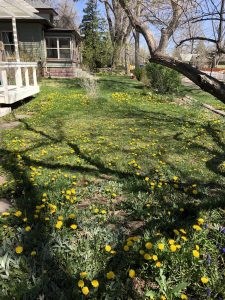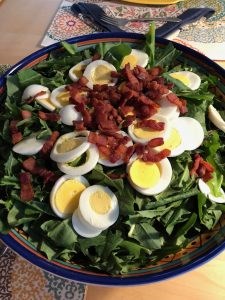This content was originally published by the Longmont Observer and is licensed under a Creative Commons license.
(Written by Anne Corr)
Last week Central Elementary’s kindergarten classes made a field trip to SWEET Letterpress in Old Town Longmont. A highlight of the walk was enjoying the dandelions found on the lawns and in the green spaces that edged the sidewalks. The children gathered great bunches of yellow blossoms, presenting them to their friends. I walked with kindergartner Joshua Davis who peered into the center of one blossom that had yet to explode. I showed him the jagged leaf of another plant, explaining that the term dandelion comes from the French “dent de lion” or “tooth of the lion.” I explained that you can eat the leaf and he looked at me intently, thinking that over.
Talking about eating dandelions made me hungry for them and I went home and gathered what I had in my yard, from plants just starting to bloom. Dandelion salad is a welcome sign of spring. You can still eat the leaves after they flower, but it is the first green leaves that are most tender. Just be sure they are from a yard free of animals or herbicides. Since I am currently dog-free, my yard is an ideal dandelion patch.

The bane of well-groomed lawn-lovers, dandelion is one of nature’s most nutritious spring heralds. It has been eaten for centuries to supply much-needed vitamins to people who subsisted on a winter diet of meats or beans and dried or salted foods. As welcome as a fragrant spring breeze, dandelions provide the body with a powerhouse of vitamins and minerals.
Cooked dandelion greens, in a one cup or 100 gram portion, provide enormous amounts of vitamin A and substantial amounts of vitamin C. They are a rich source of lutein and zeaxanthin, two carotenoids that protect against age-related macular degeneration and cataracts. Also rich in B vitamins and calcium, dandelions are low in calories—about 35 for a cup of the cooked vegetable and 45 calories, before the dressing, for raw.
The first sign of dandelion’s emergence is a reddish tangle of leaves at the top of a very steadfast perennial root. The roots can be peeled, cooked and eaten as a vegetable like parsnips or they can be roasted in a low oven for four hours until they break with a snap. Ground dandelion roots are a coffee substitute and can be enjoyed as you would your coffee, with or without a sweetener and cream.
On the top of the dandelion root is a crown of whitish leaf stems that reaches to the surface. This tender crown can be eaten raw in salad or cooked like a vegetable. The part that develops into the blossom is found inside the crown as a tightly packed, yellowish mass of embryonic bloom and can be lightly cooked and seasoned and enjoyed as a vegetable reminiscent of artichokes.
Once the flower blooms, salad days are over, though some folks like to collect the blossoms to make into wine. The puffy seeds masses are not at all edible but are highly esteemed by children who like to make wishes on them and then see if they can blow them all off. The Central kindergartners did this with gusto on the walk back, ensuring a long season of yellow blossoms.
The following recipe is a great way to make use of an abundance of clean, unsprayed dandelion greens. If you have violets in your yard, the blossoms are edible and make a great garnish. Eat the weeds!

Dandelion Salad with Hot Bacon Dressing
Serves 6
4 quarts dandelion greens
4 strips bacon, sliced into thin strips
1/3 cup sugar
2 tablespoons flour
1 teaspoon salt
½ cup apple cider vinegar
1 ½ cups water
1 egg, beaten
3 hard boiled eggs, sliced
Wash, dry and cut up tender dandelion greens. Cook bacon over medium low heat until crisp. Remove cooked bacon from the pan and reserve. In a medium bowl, combine sugar, flour and salt. In liquid measure combine vinegar, water and beaten egg. Pour liquids into dry ingredients and mix until smooth. Pour this mixture into the bacon drippings and heat, whisking constantly until the mixture thickens and boils for one minute. Pour hot dressing over the dandelion greens and top with cooked bacon and hard-boiled egg slices. Toss lightly and serve immediately.
Well Seasoned is a new column by Anne Quinn Corr. Anne has been a food writer for over 30 years. She enjoys seeking out local foods, providing some information about the ingredient, and creating a recipe that is easy to make in your own kitchen.


